Table of contents
5 Facts About an at Home Food Sensitivity Test
- Purpose: People might feel that certain foods can make them feel bloated, sluggish, causing digestive and even skin problems. These at home kits help patients determine if these reactions may be due to food sensitivities.
- How it Works: The process starts with the customer visiting the testing company’s website. Users then purchase the kit, which arrives within 5-7 days, take the samples needed with the contents provided, and mail them back.
- Cost: The investment in these at home tests will depend on the types and number of foods you want to test for. Prices range from $88 to $200.
- Results: Your results will tell you how your IgG antibodies react to the number of foods tested. After sending the sample back, results should be available within 2-3 days.
- Recommended product: Nebula 30X Whole Genome Sequencing is a reliable DNA Test that decodes all of your genetic blueprints with high accuracy
What is an at Home Food Sensitivity Test?
An at home food sensitivity test will identify food sensitivities to specific foods. Before getting started with the basics of this test, let’s describe what food sensitivity is in the first place.
Food sensitivity happens when your digestive system has an adverse reaction to eating certain foods. On the other hand, an allergy from food occurs when the immune system negatively reacts to a specific meal. It is important to distinguish between them.
Food sensitivity is not life-threatening, and its symptoms include bloating, gas, stomach pain, diarrhea, cramping, nausea, and constipation. On the other hand, food allergies can be life-threatening and include hives, itching, swelling, dizziness, and anaphylaxis.

In essence, food sensitivities are not mediated by the immune system but are caused by a digestive system’s inability to digest or process food. You can be sensitive to either artificial or naturally occurring ingredients.
What does this test look for?
An at home food sensitivity test checks your body’s immune response to different types of foods. Sensitivities are driven by the antibody immunoglobulin G (IgG). Allergies, on the other hand, are caused by the antibody immunoglobulin E (IgE antibodies).
This test measures your immune system’s IgG reactivity to a list of meals. This is where tests may vary. Some will test for 200 common foods, and others will claim to examine up to 600.
These are the main groups or food sensitivities most tests examine:
- Dairy
- Vegetables
- Grains
- Legumes
- Fruits
- Eggs
- Meats
- Seafood
- Seeds and nuts
- Spices
- Preservatives
- Additives
- Tree nuts
- Celiac gluten sensitivity (the basis of celiac disease)
There are large differences between the tests, mainly in the types of food they test, the cost, and the type of support regarding dieting and lifestyle choices.
How does this test work?
Given the amount of delicious meals we consume every day and the number of ingredients in every bite, it is difficult to determine exactly which foods you are sensitive to. This is where these at home tests come in to help you identify trigger foods.
The lab will examine your body’s IgG immune response to each food included in the offer’s panel. But what exactly is immunoglobulin G?
Your blood contains large amounts of antibodies, known as immunoglobulins, whose function is to fight bacteria, viruses, and any other invader entering the bloodstream. When these antibodies find an invader, they will fight it by triggering an immune response.
We can find five different types of antibodies in your blood. IgG is one of them.
For example, if you have an allergic reaction to a particular food, you might experience sneezing and a runny nose. This response is mediated by IgE, so it is not a sensitivity.
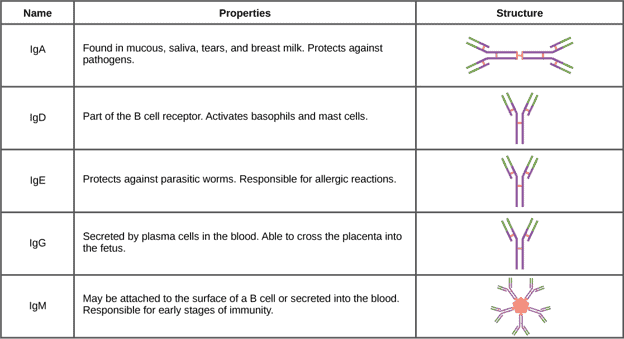
Allergic responses are almost immediate. However, sensitivity responses are slower. When a particular food you are sensitive to enters your bloodstream, IgG antibodies mistakenly label them a threat. At the molecular level, they attach to these particles, tagging them and generating an immune response.
Basically, these immunoglobulins act as markers for that food, signaling your immune system that it is a threat to the body. Your immune system’s response? The release of inflammatory cytokines, a group of chemicals that promote inflammation.
As these cytokines circulate through your bloodstream, they can hurt you, causing symptoms particular to food sensitivity. Some of these symptoms include headaches, abdominal pain, muscle or joint pain, and others.
An at home food sensitivity test requires a blood sample to conduct an IgG test. This test measures the amount of IgG antibodies found in your blood test as a response to each type of meal in the offering panel. The results will then tell you your immune system’s response to each particular food. So, this is an IgG reactivity test.
How Much Does an at Home Food Sensitivity Test Cost?
The offer for these types of tests is ample. There is currently no at home test for food allergies. If you are concerned about allergic reactions, you must contact your doctor to discuss an in-person food allergy test.
As mentioned earlier, test prices vary due to several factors.
- EverlyWell: They have two options:
- $159, and it measures IgG reactivity for 96 different items
- $259, and it measures IgG reactivity for 204 different items
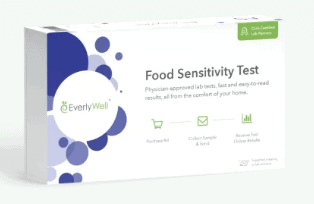
- DNAfit: $132.30. This test involves genetic testing to determine a better diet. Food sensitivity is included to help create a personalized meal plan.
- Check My Body Health: They offer two options:
- Essentials Health Sensitivity test: $65, and it tests for 400 items
- Complete Health Sensitivity test: $90 and a test for 970 items
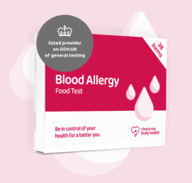
- Walmart: $88 and a test for 600 items. For this test, you need to send a hair sample that is tested with bioresonance technology.
Other tests include 5Strands, Allergytest.co, Simply Sensitivity Checks, and YorkTest Laboratories. You can read our reviews to learn more!
Getting Started with an at Home Food Sensitivity Test
Perhaps the first question that comes to mind when deciding which at home food sensitivity test to take is how many foods you want to test for. A test that has many items in its panel certainly sounds good. But maybe you do not need such a large list and pay the increased cost. Some diets and lifestyles do not include certain foods so you may know ahead of time that they would not be affecting your health.
Consider that you should take a food sensitivity test if you notice symptoms such as bloating and discomfort when you eat a particular meal group.
You should not confuse sensitivity with intolerance either. Food intolerance is the result of a specific enzyme deficiency in the body. The most well-known type is lactose intolerance, for instance. Dairy products contain a protein called lactose. In the body, an enzyme called lactase breaks down lactose into simpler digestible substances. When your small intestine does not produce enough lactase, it cannot digest all the lactose you put into your body.
Intolerance is classified based on how much of and how often the tolerated food needs to be consumed to cause a reaction. Some can eat a small amount without a reaction to food, while others will feel the effects after only a small exposure.
You must know that an at home food sensitivity test will measure the IgG immune response to certain foods. It is not intended to find allergies or to diagnose intolerance due to low enzymatic activity.
All this being said, the first step to get started with your at home food sensitivity test is to go to the website and make your order. Ensure the site is reputable.
Think of the type of foods you suspect are causing you to bloat, have headaches, etc., and verify that they are listed within the panel offered in the test. For example, let’s say that every time you drink coffee, your heart races abnormally. Verify that coffee is included in the list of foods this test looks for.
You should receive your kit within 3-5 days. It may vary, but most testing kits include:
- A collection card or collection tube
- Alcohol gauze
- Lancets for finger pricking
- Biohazard bag
- Bandage
- Prepaid shipping label
- Instructions
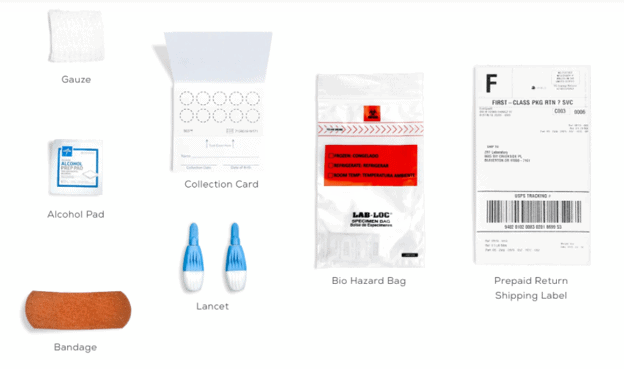
There are no dietary changes needed for this test. Upon receiving your kit, you should get a unique code to register on the testing company’s website. This will help the website share your results with you in privacy.
Before taking the test, you are advised to:
- Drink a large glass of water
- Wash your hands with warm water
- Do some minor physical activity to get your heart rate up
- Shake your hands for 15-20 seconds
When you prick your finger (usually your ring finger), clean off the first drop of blood coming out and start collecting per instructions given in the manual.
To get the blood flowing out, you should squeeze the blood out of your finger by massaging it. If you are using a collection card, you need to wait for the blood to dry out.
Mail your samples and expect an email with a unique code to check your results online. This usually takes about two days to arrive.
At Home Food Sensitivity Results
Once you get your results, you will get accurate information about how reactive your IgG antibodies are to the foods tested by the company. In other words, it will tell you how strongly your immune system reacts to those foods. Typically, the test uses a scale to represent reactivity levels and places each meal within a range.
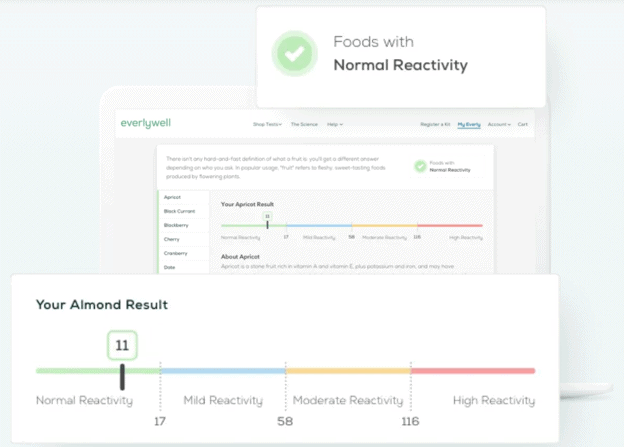
Some testing companies will add a list of recommendations, steps to follow, and even some alternative foods you may want to include or eliminate from your diet.
The results have the same accuracy as those you get from a lab. Please keep in mind that your results are not intended to provide medical diagnosis and are not a substitute for professional advice, diagnosis, or treatment.
The next step is to use your results to effectively cut down the foods that cause your unpleasant symptoms. Here’s where an elimination diet is in order.
At home food sensitivity test and elimination diet
This is also referred to as a temporary elimination diet as it requires you to avoid certain foods for a certain period of time before slowly reintroducing them into your diet. From your at home food sensitivity test, select those items that present a high or moderate reactivity to IgG and plan to temporarily eliminate them from your diet. First, stop eating them for four weeks. Then, to keep your diet balanced, find substitutes for these foods.
Let’s say that you find that blueberry is causing a high IgG reactivity. You will stop eating blueberries for four weeks. You also note a moderate IgG reactivity to oats. So you stop eating any foods with oats in them. Substitute the blueberries with raspberries, grapes, strawberries, or pomegranates to provide proper nutrition. You can substitute oats with chia seed or quinoa.
After four weeks have passed, select one of the foods you removed from your diet and reintroduce it. Eat one serving and do not eat it or reintroduce a new one for 2-4 days. Carefully check for any symptoms and, if possible, keep a journal.
If you do not experience any symptoms after 2-4 days, this means that you may reintroduce this food and eat it within your diet. However, if you do experience symptoms, you should stop consuming it for 3-6 months before reintroducing it.
Follow the above steps with each food that has a high and moderate IgG reactivity in your test results one by one.
We recommend you consult with your dietician or health care professional about the elimination diet. Sometimes, it will be tricky to eliminate certain foods from your diet and find proper substitutes. Without medical advice, you may experience adverse reactions such as unintended weight loss or nutrient deprivation.
You may also be interested in these other wellness tests you can take from home:
- Women’s health test (hormones, cholesterol, nutrients, and more)
- Men’s health test (hormones, proteins, cholesterol, and more)
- Heart health test (cholesterol and other lipids)
- Inflammation test (CRP, vitamin D, Procalcitonin, and more)
- Vitamin D test (hydroxyvitamin D levels)
- Cholesterol test (total cholesterol, HDL, LDL, and triglycerides)
- Thyroid test (TSH, FT4, FT3, and TPO)
- Testosterone test (total, free, SHGB binding, albumin binding)
- Metabolism test (testosterone, TSH, cortisol, and progesterone)
Edited by Christina Swords, PhD
